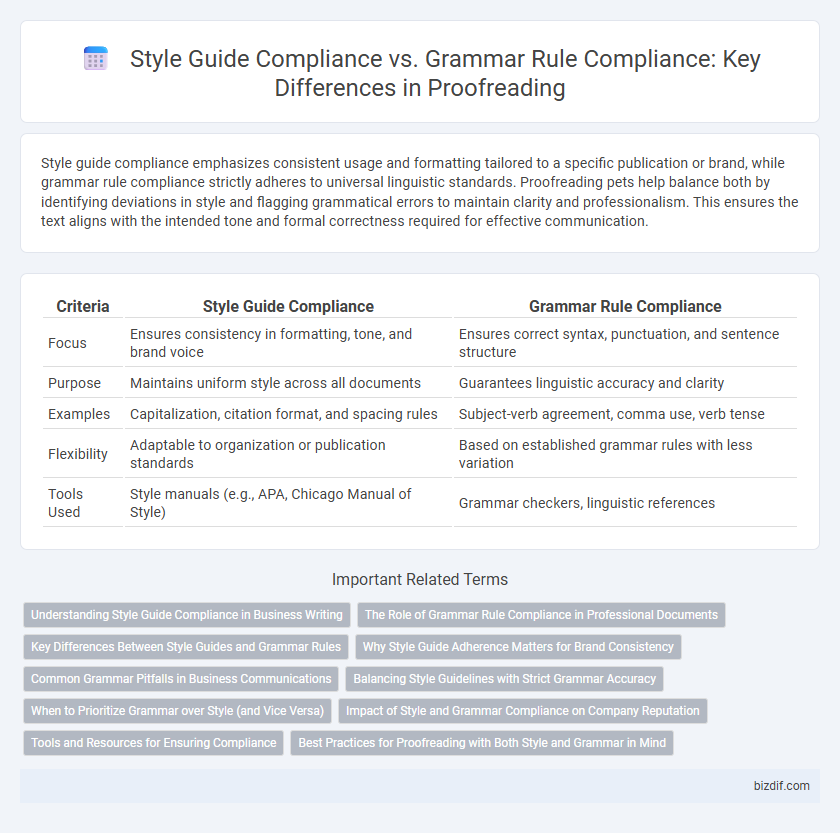Style guide compliance emphasizes consistent usage and formatting tailored to a specific publication or brand, while grammar rule compliance strictly adheres to universal linguistic standards. Proofreading pets help balance both by identifying deviations in style and flagging grammatical errors to maintain clarity and professionalism. This ensures the text aligns with the intended tone and formal correctness required for effective communication.
Table of Comparison
| Criteria | Style Guide Compliance | Grammar Rule Compliance |
|---|---|---|
| Focus | Ensures consistency in formatting, tone, and brand voice | Ensures correct syntax, punctuation, and sentence structure |
| Purpose | Maintains uniform style across all documents | Guarantees linguistic accuracy and clarity |
| Examples | Capitalization, citation format, and spacing rules | Subject-verb agreement, comma use, verb tense |
| Flexibility | Adaptable to organization or publication standards | Based on established grammar rules with less variation |
| Tools Used | Style manuals (e.g., APA, Chicago Manual of Style) | Grammar checkers, linguistic references |
Understanding Style Guide Compliance in Business Writing
Understanding style guide compliance in business writing ensures consistency in tone, formatting, and terminology across all communication materials, which enhances brand professionalism and clarity. Style guides like APA, Chicago, or company-specific manuals dictate preferred practices beyond basic grammar rules, aligning content with organizational standards and audience expectations. Emphasizing style guide adherence promotes coherent messaging and supports legal and ethical compliance in corporate communications.
The Role of Grammar Rule Compliance in Professional Documents
Grammar rule compliance ensures clarity, consistency, and correctness in professional documents by adhering to established linguistic standards. It reduces ambiguity, enhances readability, and supports effective communication across diverse audiences. Strict grammar adherence fosters credibility and professionalism, making documents more persuasive and authoritative in formal settings.
Key Differences Between Style Guides and Grammar Rules
Style guide compliance emphasizes consistency in formatting, tone, and usage specific to a publication or organization, while grammar rule compliance strictly adheres to universal linguistic correctness. Style guides allow flexibility and variations tailored to target audience preferences, whereas grammar rules provide the foundational structure governing sentence construction and language mechanics. Understanding the distinction enhances clarity and professionalism in written communication by balancing prescriptive norms and adaptive guidelines.
Why Style Guide Adherence Matters for Brand Consistency
Adhering to a style guide ensures consistent tone, terminology, and formatting across all brand communications, which strengthens brand identity and fosters trust with the audience. While grammar rule compliance is essential for clarity and correctness, style guide adherence aligns writing with brand values and target audience expectations, maintaining professionalism and recognition. Consistent application of style guides reduces brand confusion and supports cohesive messaging in marketing, product documentation, and customer interactions.
Common Grammar Pitfalls in Business Communications
Common grammar pitfalls in business communications often involve misplaced modifiers, subject-verb agreement errors, and improper use of punctuation, which can undermine clarity and professionalism. Style guide compliance ensures consistency in tone, format, and terminology across documents, while grammar rule compliance focuses on correct sentence structure and syntax. Balancing both is essential for effective business writing that maintains credibility and aligns with organizational standards.
Balancing Style Guidelines with Strict Grammar Accuracy
Achieving a balance between style guide compliance and grammar rule compliance is essential for polished and professional writing. While strict adherence to grammar rules ensures clarity and correctness, aligning with a style guide provides consistency tailored to specific audiences or industries. Writers should prioritize clarity and reader engagement while applying grammar rules flexibly within the framework of the chosen style guidelines.
When to Prioritize Grammar over Style (and Vice Versa)
Prioritize grammar rule compliance in formal documents where clarity and correctness directly impact understanding or legal validity. Style guide compliance becomes essential when maintaining brand voice, consistency, and target audience engagement, especially in marketing or internal communications. Balance both by following strict grammar rules for readability while adapting style guidelines to enhance tone and alignment with organizational standards.
Impact of Style and Grammar Compliance on Company Reputation
Consistent adherence to style guide compliance enhances company reputation by ensuring brand voice uniformity and professionalism across all communications. Grammar rule compliance prevents misunderstandings and errors that could undermine credibility and trustworthiness with clients and stakeholders. Together, strict compliance with style and grammar standards strengthens overall corporate image and fosters positive perceptions in the market.
Tools and Resources for Ensuring Compliance
Style guide compliance and grammar rule compliance require distinct tools and resources to ensure accuracy. Style guides like APA, MLA, or Chicago offer comprehensive manuals and digital checklists tailored to specific formatting and citation standards. Grammar compliance benefits from advanced proofreading software such as Grammarly or ProWritingAid, which provide real-time suggestions for syntax, punctuation, and usage errors.
Best Practices for Proofreading with Both Style and Grammar in Mind
Effective proofreading balances strict grammar rule compliance with adherence to a prescribed style guide, ensuring consistency and clarity across all documents. Best practices include cross-referencing style-specific guidelines on tone, formatting, and punctuation alongside standard grammar checks to maintain both linguistic accuracy and brand voice. Utilizing tools that integrate customizable style rules with grammar error detection enhances precision and streamlines the proofreading process.
Style Guide Compliance vs Grammar Rule Compliance Infographic

 bizdif.com
bizdif.com